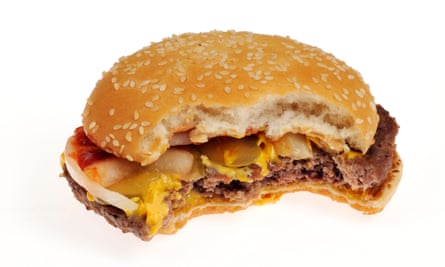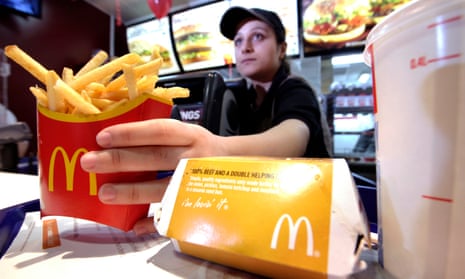“Journey”: a funny word to use about fast food. Journeys are things that X-Factor contestants go on as they move from being tone-deaf wannabes with some sort of speech impediment/dying family member/uncontrollable flatulence to still being tone-deaf wannabes with problems – but with slightly better hair.
Nonetheless, in an attempt to make us all forget they have spent most of the past century pumping kiddies full of high-fructose corn syrup, McDonald’s announced at an Illinois press conference this week that it would like us all to pay attention to its “food journey”. As an ex-employee of the frozen burger slingers, my feeling is that the only food journey they are usually involved in is a pissed post-pub stagger. But hey! What do I know? Let’s look back on that food journey over recent years and let the facts speak for themselves.
2005: salads are introduced
A crossroads is reached in Ronald McDonald’s journey. For some reason, people seem to have got it into their heads that McDonald’s may not be the most advisable diet choice if you want to avoid gunking up your arteries with hardened cholesterol. What to do? Introduce salads, of course: including the grilled chicken salad, which – when eaten with dressing – contains more calories than a hamburger and more fat than a hamburger and chips. Sales rocket, committing McDonald’s so firmly to this path that in February 2016 they introduce a kale salad in the US, which contains more salt, fat and calories than a Big Mac. No wait, sorry: make that a Double Big Mac.

July 2007: organic milk becomes standard in the UK (sort of)
As pesky consumers become ever more interested in the provenance of their food, McDonald’s realises that its path lies with introducing organic milk as standard for tea and coffee, thus making them potentially responsible for consuming 5% of the UK’s entire organic milk output. Although they don’t start using it in McFlurries, Milkshakes, Ice Cream or any of their offerings that are largely milk-based. But: shhh. The whole nation is now definitely, definitely convinced that Maccy D’s is now the fast food equivalent of Whole Foods.
July 2014: McDonald’s caught using expired meat in Chinese branches
A truly inspiring step in the burger chain’s journey, as they remove chicken nuggets and chicken burgers from their menu in Hong Kong after a TV programme reveals that one of their suppliers is using expired chicken. Similarly moving incidents occur the following year in Japan when their chicken nuggets are recalled after plastic was found inside them and the company goes on to apologise for a child injuring his mouth on a sundae containing plastic and a woman finding a tooth in her fries.
May 2016: the “fresh beef” initiative
Only 76 years after opening, McDonald’s have a brainwave: that it may, perhaps, be a nice idea to make burgers out of patties that aren’t so solidly frozen into a meaty tower of babel that it requires McWorkers to smash them against a hard surface to separate them out before grilling (I speak from personal experience). In 14 restaurants in Dallas, they decide to begin experimenting with something called “fresh beef”. But only in their quarter pounders, mind. After all, this thing about using ingredients that don’t require scrabbling around in a frosty cabinet might turn out to be a fad.
August 2016: not pumping food full of crap becomes a priority
Us fussy Brits will never know the true beauty of a McDonald’s meal. We have not had to endure ammonia-infused pink slurry in meat. So we’re left having to imagine the wondrous emotional impact of Maccy D’s latest glorious step on their food journey: taking high-fructose corn syrups out of their buns, no longer feeding antibiotics to their chickens and resisting the temptation to pump their scrambled eggs full of preservatives. Sounds lovely, though, doesn’t it? What a charming end to a poignant food journey.
Bonus quiz
In 2008, what did McDonald’s do to alleviate health concerns about their French fries?
1. Introduce a trial run of healthy, vegetable-based side dishes
2. Try baking the fries, thus allowing them to massively reduce the oil content
3. Carry on deep-fat frying them in buttloads of oil, but make sure that it was oil containing no trans fats - totally healthy.
Yep, correct. It’s number 3.
In 2002, what vegetarian-pleasing initiative did McDonald’s engage in?
1. Announce a veggie-only day in which all beef patties were replaced by aubergines.
2. Pay for a free massage to all cows on ranches they use.
3. Settle a court case for $10m after having labelled their fries as vegetarian despite containing beef broth.

Comments (…)
Sign in or create your Guardian account to join the discussion